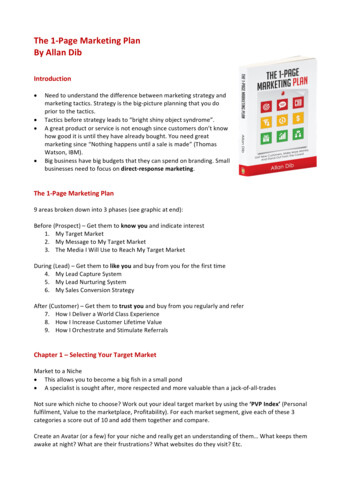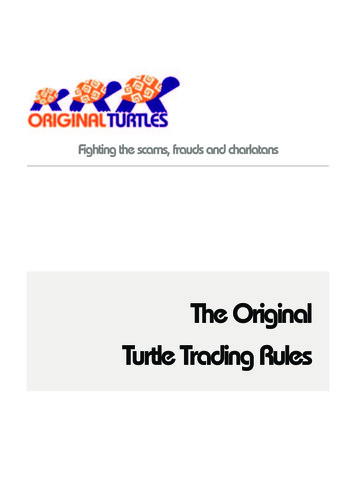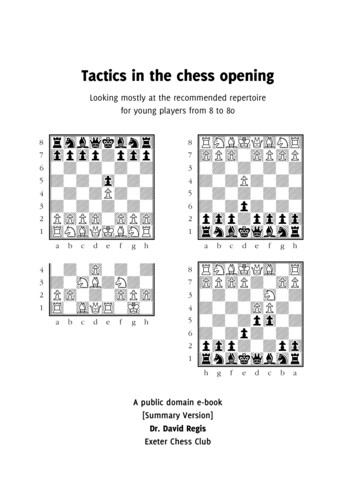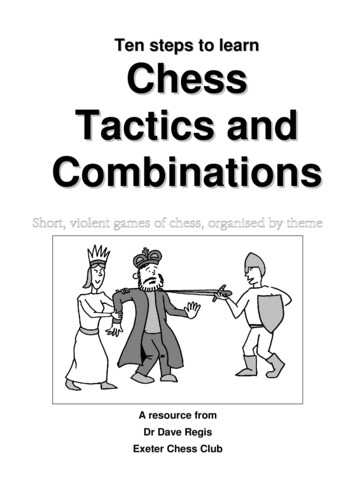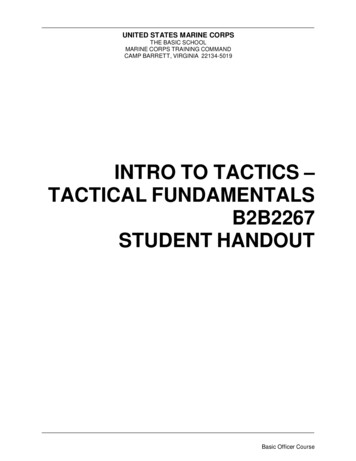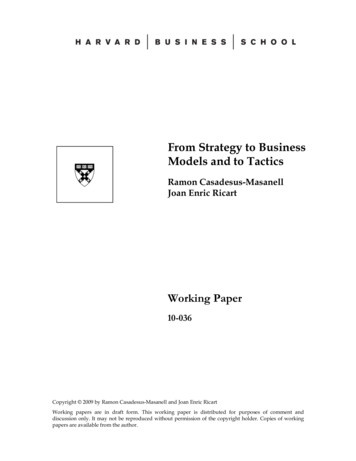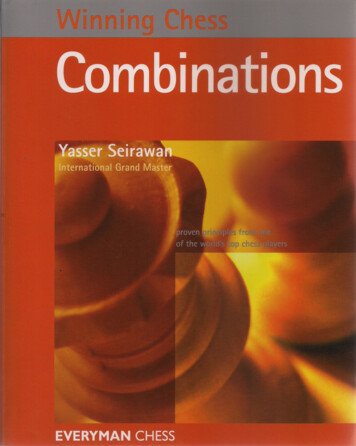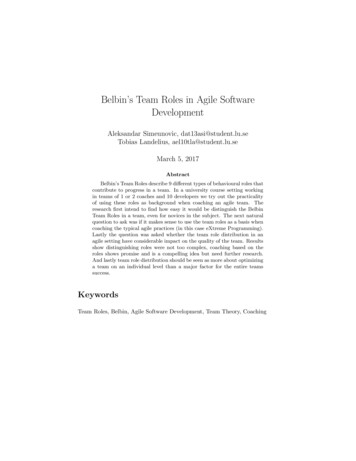
Transcription
Team TacticsIntroductionThis manual is designed to introduce you to a wide selection of Fundamental and AdvancedTactical principles for effective team performances such as Systems of Play, Attacking TeamTactics, Defensive Team Tactics, Small Group Tactics, Attacking Restarts and Set-Play’s,Defensive Restarts and Set-Play’s.Copyright, TheICA.com All Rights Reserved2
SYSTEMS OF PLAYThe 4-4-2 SystemThe 4-4-2 is one of the most common systems played today. The formation provides eightplayers behind the ball when defending and four players ready to support the two forwards whenattacking. The two wide midfielders are used as wingers, providing automatic width to the midfieldshape. The use of four defenders adds more compactness and balance in the back. Either thesweeper or the flat back four system can be utilized.Role of the Four DefendersThe back four defenders must play as one unit around the entire defensive half of the field.Most often teams will use one central defender (stopper) as a man for man marker and thesecond as a sweeper or covering defender. Some teams opt for a ‘"flat back four" with bothcentral defenders sharing the responsibility of marking.This system is often preferred with the "offside trap" tactics. The advantage of a 4-4-2 system isthat it also allows more freedom for the two wide defenders to attack.Role of the Two Wide Defenders Must play as one unit around the entire defensive half of the field.Maintain compactness to support each other and avoid being spread out.Must play as one unit up and down the wide channel with the midfield and wide forward.3
Provide instant width when building possession from the back.Deepest defender acts as the leader for providing information to the other threedefenders.Disciplined in maintaining defensive responsibility, even when their team is attacking.Ability to defend on a 1 v 1 basis. Knowing when to delay and when to challengean oncoming opponent.Support both the middle and wide midfield players by providing an option of an overlapor a supporting position behind the ball.Role of the Two Central Defenders Must play as one unit around the entire defensive half of the field.Maintain compactness to support each other and avoid being spread out.Must play as one unit up and down the center channel with the midfield and forwards.Communicate well with co-center back, knowing when to mark tight and when to dropdeeper into a supporting position.Provide central cover when building possession from the back.Deepest defender acts as the leader for providing information to the other threedefenders.Disciplined in maintaining defensive responsibility, even when their team is attacking.Ability to defend on a 1 v 1 basis. Knowing when to delay and when to challengean oncoming opponent.Support both the middle and wide midfield players by providing an passing option behindthe ball.Role of the Four Midfielders as a UnitThe four midfielders are the link between offense and defense and must operate from penaltyarea to penalty area. The wide midfielder must act as a fifth defender when the opponents areattacking on the opposite side of the field. He should occupy the space in the fullback positionand add cover whenever possible. The two central midfielders should look to keep their positionin the middle of the field.Role of the Two Wide Midfielders Must play as one unit across the middle of the field with the two central midfielders.Must play as one unit up and down the field with the wide defender and wide forward.Must act as a fifth defender when the opponents are attacking on the opposite side of thefield, occupying the space in the fullback position and add cover whenever possible. Get into advance positions of the ball whenever their team can play forward. Look for blind-sided runs behind the defender when their team is attacking onthe opposite side of the field. Deliver early crosses to forwards.Deliver a variety of crosses into the far and near post. Use a variety of crossingtechniques such as the bent cross, driven cross and lofted cross.Role of the Two Central Midfielders Must play as one unit across the middle of the field with the two wide midfielders.Must play as one unit up and down the field with the defenders and forwards.Maintain shape in the middle of the field and not become too isolated from each other.Team organizers and pace setters. Increase and lower the team tempo when needed.Use of cross over runs to create space for open passes when defenders are looking toplay from the back.Use of deep probing runs into the attacking third to lose markers while attacking.4
Provide defensive cover for wide midfielders.Track opponents attacking midfield runs deep into their own penalty area.Short quality passes to forwards feet and long well paced passes expose area behind theopponents' defenders.Frequent use of "give and go" passes to link up with each other.Frequent use of "give and go" passes to link up with forwards.Constantly playing with the head up to scan the field and instantly assess the bestforward passing option.Role of the Two ForwardsThe two forwards must play as one unit across the front line constantly being aware of eachother's movements. It is important to ensure they do not congest the four midfielders by droppinginto deep forward positions. Both players should be continually searching for space to receive apass, create shooting opportunities and score goals. Runs can be somewhat isolated to thecenter channel due to the automatic width provided by the two wide midfielders. Must play as one unit in the attacking third of the field working in close partnership with aco-striker, developing understanding of when and where to move with the ball, pass,dribble or shoot.Must interchange with wide midfielders in flank positions.Constantly looking to maintain balance to prevent bunching.Constantly looking to exploit space created by other forward.Constantly looking to create space for other forward to exploit.Create space for players coming from deeper positions.Press deep onto opponent's defense to create space for midfield play.Showing as a presentable target for short and long-range passes.Copyright, TheICA.com All Rights Reserved5
The 3-5-2 SystemThe 3-5-2 System is normally opted for when coaches have an abundance of midfield players.It can be used both as an attacking or defensive system. Using this formation teams usuallydefend and attack in two units, the back three and midfield five when defending, or the midfieldfive and the two forwards when going for goal.Role of the Three DefendersThe back three must be out and out defensive players. There is little freedom to go forward fromthe back due to the minimum number of defenders. Most often teams will use two of thedefenders as man for man markers with the third defender acting as a sweeper or coveringplayer. Team may also opt to play a zonal system where each player is responsible for an areaand marks any player within that area. Another possibility is to use the midfield sweeper who sitsin front of the defense and cuts out threats early. Must play as one unit across the back.Use two markers and one sweeping or covering player.The sweeper covers the full back and picks up loose balls or attacks opponents whohave broken through.The sweeper must be able to read the game well, distribute the ball well, play confidentlyand calmly under pressure and come out of defense with the ball on the break.Maintain compactness to support each other and avoid being spread out.Deepest defender acts as the leader for providing information to the other two.6
Role of the Five Midfielders as a UnitThe five midfielders are the link between offense and defense and must operate from penaltyarea to penalty area. The wide midfielder must act as a fourth defender when the opponents areattacking on the opposite side of the field. They should occupy the space in the fullback positionand add cover whenever possible.The three central midfielders should look to keep their position in the middle of the field. If bothwide midfielders attack and are in advanced positions, one of the midfield players may have toremain in a deep position to stop any swift counter attack if possession is lost.Role of the Two Wide Midfielders Must play as one unit across the middle of the field with the three central midfielders.Must play as one unit up and down the field with the wide defender.Create width in attack.Must act as a fourth defender when the opponents are attacking on the opposite sideof the field, occupying the space in the fullback position and add cover wheneverpossible.Get into advance positions of the ball whenever they can play forward. Insurance ofhaving three central defenders should provide encouragement to attack at any and everyopportunity.Look for blind-sided runs behind the defender when their team is attacking on theopposite side of the field.Carry the ball forward and deliver crosses to forwards and midfielders.Deliver a variety of crosses into the far and near post.Use a variety of crossing techniques such as the bent cross, driven cross and loftedcross.Role of the Three Central Midfielders Must play as one unit across the middle of the field with the two wide midfieldersMust play as one unit up and down the field with the defenders and forwards.Maintain shape in the middle of the field and not become too isolated from each other.Team organizers and pace setters. Increase and lower the teamtempo when needed.Use of cross over runs to create space for open passes when defenders are looking toplay from the back. Getting possession of the ball from defense and carrying it forward.Use of deep probing runs into the attacking third to lose markers while attacking.Provide defensive cover if both wide midfielders attack and are in advanced positions.One midfielder may have to remain in a deep defensive position to stop any swift counterattack if the ball is lost.Track opponents attacking midfield runs deep into their own penalty area.Short quality passes to forwards feet and long well paced passes expose area behindthe opponents’ defenders.Frequent use of "give and go" passes to link up with each other.Frequent use of "give and go" passes to link up with forwards.Constantly playing with the head up to scan the field and instantly assess the bestforward passing option.Role of the Two ForwardsThe two forwards must play as one unit across the front line constantly being aware of eachother's movements. It is important to ensure they do not congest the five midfielders by droppinginto deep forward positions. Both players should be continually searching for space to receive a7
pass, create shooting opportunities and score goals. Runs can be somewhat isolated to thecenter channel due to the automatic width provided by the two wide midfielders. Must play as one unit in the attacking third of the field working in close partnership with aco-striker, developing understanding of when and where to move with the ball, pass,dribble or shoot.Must interchange with wide midfielders in flank positions.Constantly looking to maintain balance to prevent bunching.Constantly looking to exploit space created by other forward.Constantly looking to create space for other forward to exploit.Create space for players coming from deeper positions.Press deep onto opponents defense to create space for midfield play.Showing as a presentable target for short and long range passes.Ability to loose a man for man markers in and around the penalty area through intelligentruns.Ability to make intelligent runs and decisions on where and when to receive passes intofeet and into space.Copyright, TheICA.com All Rights Reserved8
The 4-3-3 SystemWhen playing a 4-3-3 System the team will generally play a narrow game through the middle,although the fullback and wide midfield man should be encouraged to play wide when the ball ison their side of the field. The two full backs provide automatic width when possession is built fromthe back. Using this formation teams usually defend and attack in two units, either the back fourand midfield three when defending and one forward, or one defender, plus the midfield three andthe three forwards when going for goal.Role of the Four DefendersThe back four defenders must play as one unit around the entire defensive half of the field.Most often teams will use one central defender (stopper) as a man for man marker and thesecond as a sweeper or covering defender. Some teams opt for a ‘"flat back four" with bothcentral defenders sharing the responsibility of marking.This system is often preferred with the "offside trap" tactics. The advantage of a 4-3-3 system isthat it also allows more freedom for the two wide defenders to attack.Role of the Two Wide Defenders Must play as one unit around the entire defensive half of the field.Maintain compactness to support each other and avoid being spread out.Must play as one unit up and down the wide channel with the midfield and wide forward.Provide instant width when building possession from the back.Deepest defender acts as the leader for providing information to the otherthree defenders.9
Disciplined in maintaining defensive responsibility, even when their team is attacking.Ability to defend on a 1 v 1 basis. Knowing when to delay and when to challengean oncoming opponent.Support both the middle and wide midfield players by providing an option ofan overlap or a supporting position behind the ball.Role of the Two Central Defenders Must play as one unit around the entire defensive half of the field.Maintain compactness to support each other and avoid being spread out.Must play as one unit up and down the center channel with the midfield and forwards.Communicate well with co-center back, knowing when to mark tight and when to dropdeeper into a supporting position.Provide central cover when building possession from the back.Deepest defender acts as the leader for providing information to the other threedefenders.Disciplined in maintaining defensive responsibility, even when their team is attacking.Ability to defend on a 1 v 1 basis. Knowing when to delay and when to challengean oncoming opponent.Support both the middle and wide midfield players by providing an passing option behindthe ball.Role of the Three MidfieldersThe three midfielders are the link between offense and defense and must operate from penaltyarea to penalty area. It is important to keep the shape in the midfield because of the minimumnumbers. The support play should be more in behind the three forwards rather than runs beyondthem. Must play as one unit across the middle of the field and interchange positions witheach other.Understanding of "when" and "where" to use cross-over plays, diagonal runs versusstraight runs, playing to feet or space and running with or without the ball.Must play as one unit up and down the field with the defenders and forwards.Maintain shape in the middle of the field and not become too isolated from each other.Team organizers and pace setters. Increase and lower the team tempo when needed.Use of cross over runs to create space for open passes when defenders are looking toplay from the back. Getting possession of the ball from defense and carrying it forward.Use of deep probing runs into the attacking third to loose markers while attacking.Provide defensive cover if both wide midfielders attack and are in advanced positions.One midfielder may have to remain in a deep defensive position to stop any swift counterattack if the ball is lost.Track opponents attacking midfield runs deep into their own penalty area.Short quality passes to forwards feet and long well paced passes expose area behindthe opponent’s defenders.Frequent use of "give and go" passes to link up with each other.Frequent use of "give and go" passes to link up with forwards.Constantly playing with the head up to scan the field and instantly assess the bestforward passing option.10
Role of the Three ForwardsDue to the bonus of having an extra attacking player there is more freedom for the interchangingof positions. The wide forward should exchange runs with the central striker to create space inthe flank areas. Moreover, the wide player will have more opportunities to interact with the widemidfielder. Must play as one unit in the attacking third of the field.Must interchange with wide midfielders in flank positions.Constantly looking to maintain balance to prevent bunching.Constantly looking to exploit space created by other forward.Constantly looking to create space for other forwards to exploit.Press deep onto opponent's defense to create space for midfield play.Showing as a presentable target for short and long range passes.Understanding and appreciation for near and far post runs.Holding up the ball under pressure.Copyright, TheICA.com All Rights Reserved11
The 3-4-3 SystemThe 3-4-3 system of play is an attacking minded formation when in possession of the ball andlends to a high-pressure style of defending without the ball. Using this formation teams can easilyattack and defend with a group of seven players, either the back three and midfield four whendefending, or the midfield four and the three forwards when going for goal.Role of the Three DefendersThe back three must be out and out defensive players. There is little freedom to go forward fromthe back due to the minimum number of defenders. Most often teams will use two of thedefenders as man for man markers with the third defender acting as a sweeper or coveringplayer. Must play as one unit across the back.Use two markers and one sweeping or covering player.Maintain compactness to support each other and avoid being spread out.Deepest defender acts as the leader for providing information to the other two.Disciplined in maintaining defensive responsibility, even when their team is attacking.Role of the Four Midfielders as a UnitThe four midfielders are the link between offense and defense and must operate from penaltyarea to penalty area. The wide midfielder must act as a fourth defender when the opponents areattacking on the opposite side of the field. He should occupy the space in the fullback positionand add cover whenever possible. The two central midfielders should look to keep their positionin the middle of the field.12
Role of the Two Wide Midfielders Must play as one unit across the middle of the field with the two central midfielders.Must play as one unit up and down the field with the wide defender and wide forward.Must act as a fourth defender when the opponents are attacking on the opposite sideof the field, occupy the space in the fullback position and add cover whenever possible.Get into advance positions of the ball whenever their team can play forward.Look for blind-sided runs behind the defender when their team is attacking on theopposite side of the field.Deliver early crosses to forwards.Deliver a variety of crosses into the far and near post.Use a variety of crossing techniques such as the bent cross, driven cross and loftedcross.Role of the Two Central Midfielders Must play as one unit across the middle of the field with the two wide midfielders.Must play as one unit up and down the field with the defenders and forwards.Maintain shape in the middle of the field and not become too isolated from each other.Team organizers and pace setters. Increase and lower the team tempo when needed.Use of cross over runs to create space for open passes when defenders are looking toplay from the back. Use of deep probing runs into the attacking third to lose markers while attacking. Provide defensive cover for wide midfielders. Track opponents attacking midfield runs deep into their own penalty area. Short quality passes to forwards' feet and long well paced passes expose area behindthe opponent’s defenders. Frequent use of "give and go" passes to link up with each other. Frequent use of "give and go" passes to link up with forwards.Constantly playing with the head up to scan the field and instantly assessthe best forward passing option.Role of the Three ForwardsDue to the bonus of having an extra attacking player there is more freedom for the interchangingof positions. The wide forward should exchange runs with the central striker to create space in theflank areas. Moreover, the wide player will have more opportunities to interact with the widemidfielder. Must play as one unit in the attacking third of the field.Must interchange with wide midfielders in flank positions.Constantly looking to maintain balance to prevent bunching.Constantly looking to exploit space created by other forward.Constantly looking to create space for other forwards to exploit.Press deep onto opponent's defense to create space for midfield play.Showing as a presentable target for short and long range passes.Understanding and appreciation for near and far post runs.Holding up the ball under pressure.Copyright, TheICA.com All Rights Reserved13
The 4-5-1 SystemThe 4-5-1 system is predominantly a defensive style of play. The nature of the positioning ofplayers makes it a very difficult system to break down, particularly if your opponents aredisciplined and well organized. The burden of support in attack from the midfielders is greater dueto the lone striker up front. Playing five in the midfield provides instant width in attack and goodcoverage defensively from flank positions.Role of the Four Defenders as a UnitThe back four defenders must play as one unit around the entire defensive half of the field. Mostoften teams will use one central defender (stopper) as a man for man marker and the second asa sweeper or covering defender. Some teams opt for a ‘"flat back four" with both centraldefenders sharing the responsibility of marking. This system is often preferred with the "offsidetrap" tactics.Role of the Two Wide Defenders Must play as one unit around the entire defensive half of the field.Maintain compactness to support each other and avoid being spread out.Must play as one unit up and down the wide channel with the midfield and wide forward.Provide instant width when building possession from the back.Deepest defender acts as the leader for providing information to the other threedefenders.Disciplined in maintaining defensive responsibility, even when their team is attacking.Ability to defend on a 1 v 1 basis. Knowing when to delay and when to challenge anoncoming opponent.Support both the middle and wide midfield players by providing an option of an overlap14
or a supporting position behind the ball.Role of the Two Central Defenders Must play as one unit around the entire defensive half of the field.Maintain compactness to support each other and avoid being spread out.Must play as one unit up and down the center channel with the midfield and forwards.Communicate well with co-center back, knowing when to mark tight andwhen to drop deeper into a supporting position.Deepest defender acts as the leader for providing information to the other threedefenders.Disciplined in maintaining defensive responsibility, even when their team is attacking.Ability to defend on a 1 v 1 basis. Knowing when to delay and when to challengean oncoming opponent.Support both the middle and wide midfield players by providing a passing option behindthe ball.The Role of the Five Midfielders as a UnitThe five midfielders are the link between offense and defense and must operate from penaltyarea to penalty area. The wide midfielder must act as a fifth defender when the opponents areattacking on the opposite side of the field. They should occupy the space in the fullback positionand add cover whenever possible.The three central midfielders should look to keep their position in the middle of the field. If bothwide midfielders attack and are in advanced positions, one of the midfield players may have toremain in a deep position to stop any swift counter attack if possession is lost.Role of the Two Wide Midfielders Must play as one unit across the middle of the field with the three central midfielders.Must play as one unit up and down the field with the wide defender.Create width in attack.Must act as a fifth defender when the opponents are attacking on the opposite side of thefield, occupying the space in the fullback position and add cover whenever possible.Get into advanced positions of the ball whenever their team can play forward. Insuranceof having three central defenders should provide encouragement to attack at any andevery opportunity.Look for blind-sided runs behind the defender when their team is attacking on theopposite side of the field.Carry the ball forward and deliver crosses to forwards and midfielders.Deliver a variety of crosses into the far and near post. Use a variety of crossing techniques such as the bent cross, driven and lofted cross. Role of the Three Central Midfielders Must play as one unit across the middle of the field with the two wide midfielders.Must play as one unit up and down the field with the defenders and forwards.Maintain shape in the middle of the field and not become too isolated from each other.Team organizers and pace setters. Increase and lower the team tempo when needed.Use of cross over runs to create space for open passes when defenders are looking toplay from the back.Getting possession of the ball from defense and carrying it forward.Use of deep probing runs into the attacking third to lose markers while attacking.15
Provide defensive cover if both wide midfielders attack and are in advanced positions.One midfielder may have to remain in a deep defensive position to stop any swift counterattack if the ball is lost.Track opponents' attacking midfield runs deep into their own penalty area.Short quality passes to forwards feet and long well paced passes exposearea behind the opponents' defenders.Frequent use of "give and go" passes to link up with each other.Frequent use of "give and go" passes to link up with forwards'.Constantly playing with the head up to scan the field and instantly assess the bestforward passing option.Interchange of players between the midfield and forwards needs to be highly developed.Role of the ForwardThe forward must play as target player. It is important to ensure not to congest the fivemidfielders by dropping into deep forward positions. The forward should be continually searchingfor space to receive a pass, create shooting opportunities and score goals. Runs can besomewhat isolated to the center channel due to the automatic width provided by the two widemidfielders. The forward must be a player who is competent at holding the ball under pressure toprovide enough time for support play. Must continually be presentable as a moving target in the attacking third of the field.Must interchange with wide midfielders in flank positions.Constantly looking to exploit space.Constantly looking to create space for midfield players to exploit.Press deep onto opponent's defense to create space for midfield play.Ability to make intelligent runs and decisions on where and when to receive passes intofeet and into space.Ability to make intelligent runs and judgments on where and when to receive passes infront of the opposing defense and behind the opposing defense.Holding up the ball under pressure.Copyright, TheICA.com All Rights Reserved16
ATTACKING TEAM TACTICSAttacking Principles - “One touch play is anextremely important attacking tactic as theopposition cannot pressurize”Attacking tactics are all concerned with creation and exploitation of space by individuals and bythe team. They are as follows:Creating Space by spreading out side-to-side.A crucial fact in trying to create space both in between and behind defenders, if stretching theopposition is done quickly then they will have problems man marking and covering for each other.If possible, as soon as the ball is won, a team should stretch out side-to-side as quickly aspossible, making sure the players can see everything that is happening on the field by their bodyposition, and should try to go forward as quickly as possible having stretched the opposition.Spreading out end-to-end.This means that furthest player away from the ball should come towards it, thus creating spacebehind him to be exploited by other players running off the ball. Overlapping runs create space,both end-to-end and side-to-side. They can take place on the flanks and in central positions.17
Every "play" in soccer has a "cue" - the cue in an overlap for a player to go in advance of the ballis (1) is there space to run into? and (2) Can the man on the ball play forward into thatspace. The same one occurs in central positions, the player on the ball also has the possibility ofusing the overlapping run as a "dummy" and goes in the opposite direction.One Touch Play.One touch play is an extremely important attacking tactic as the opposition cannot pressurize youif this occurs. If one touch play is to be effective then an excellent understanding of support onand off the ball is needed. Defenders react to movement of players and quick one touch playwhich obviously requires good movement unhinges them in their positions, both in zone defenseand obviously in man-for-man marking.Changing the direction of play.Can be achieved with long diagonal passes from flank-to-flank, with crossover runs which havethe purpose of drawing defenders together to create space down either flank. Reverse passing a skill that involves running with the ball in one direction, and passing it the opposite directionshould also be used.Dribbling.Dribbling is the most exciting attacking tactic. When a crowd sees a good dribbler it excitesthem. A player who can take on and beat others or draw defenders to him creates space if theball is delivered at the right time for his tea
Tactical principles for effective team performances such as Systems of Play, Attacking Team Tactics, Defensive Team Tactics, Small Group Tactics, Attacking Re


